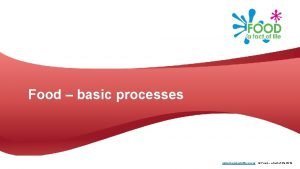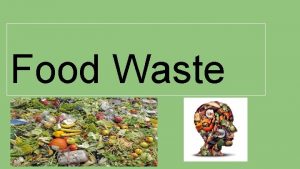Food waste www foodafactoflife org uk Food a
















- Slides: 16

Food waste www. foodafactoflife. org. uk © Food – a fact of life 2019

Food waste Every year in the UK, seven to ten million tons of food are wasted. It is thought that approximately 50% of the food wasted is still edible. The cost of food waste is significant – estimates show that it costs an average family £ 700 per year. Source: Love Food Hate Waste www. foodafactoflife. org. uk © Food – a fact of life 2019

Reasons for food waste There are many reasons why food is wasted, some of the most common items that are wasted: Bread and bread products: • consumers do not understand ‘best before’ dates and bread is thrown away while still edible; • the bread has been stored incorrectly and has dried out and gone hard; • the bread has been stored too long (beyond ‘best before’ date) and has gone mouldy. www. foodafactoflife. org. uk © Food – a fact of life 2019

Reasons for food waste Fruit and vegetables: • consumers do not store the produce correctly; • large pack size or multi-buys encourage consumers to buy more than they need; • consumers are not aware of the benefits of some packaging extending the shelf life of the product. Starchy foods: • consumers cook too much, e. g. pasta/rice – portion size too big; • leftovers thrown away. www. foodafactoflife. org. uk © Food – a fact of life 2019

Reasons for food waste Meat, chicken, fish: • consumers buy too much in advance; • food ‘goes off’ before cooking due to incorrect storage. Fizzy drinks: • the ‘fizz’ is lost when bottles are opened a few times; • larger bottles can be cheaper than small. Milk: • milk can go ‘off’ if stored incorrectly; • too much milk is poured with cereals or in drinks. www. foodafactoflife. org. uk © Food – a fact of life 2019

Reducing food waste Reducing the amount of food consumers waste not only has financial benefits but also environmental benefits. When food waste goes to landfill, it rots and during the process methane gas is produced. Methane is a greenhouse gas and contributes to global warming. Consumers should use food waste bins wherever possible. Reducing waste is a priority for both the economy and the environment. The UK is making progress but still has a long way to go. Ethically it is challenging too – despite the amount of food wasted there an increasing number of people who are in food poverty and rely on food banks. www. foodafactoflife. org. uk © Food – a fact of life 2019

Reducing food waste There are many ways in which consumers can help reduce food waste when buying food, eating out and eating at home. Common causes of food waste when shopping include: • buying multi-pack items that may not get used – share the cost and goods with a friend/family; • impulse shopping – write a list and stick to it; • tempting offers – work out if they really are a good deal, e. g. BOGOF; • confusion over date labels – be familiar with what they mean. Chose the food with the longest date. www. foodafactoflife. org. uk © Food – a fact of life 2019

Common causes of food waste when preparing and cooking food at home include: • no forward planning – plan meals in advance and make a list; • cooking too much – use portion guides and calculators when cooking; • limited cooking skills – get to know recipes that can be modified to use foods that you have available; • left-over food is not used – be creative with leftover food to save waste and money; • food is stored incorrectly – make sure perishable food is stored at the correct temperature. Make good use of the freezer. www. foodafactoflife. org. uk © Food – a fact of life 2019

Using leftovers For many reasons, including social, financial and environmental, it makes sense to make the most of the food we grow, buy and cook. This includes using leftovers smartly. Leftover ingredients can be used to create an exciting range of dishes and not just sandwiches with the cold meat left over from a Sunday roast! In the UK, it is estimated that 10 million tonnes of food and drink waste arises postfarmgate each year, 60% of which was edible. Food waste in England April 2017 However, it is important to remember that leftovers should be stored correctly and, unless they have been frozen, used within 48 hours of when they were made. Rice dishes should be eaten within 24 hours. www. foodafactoflife. org. uk © Food – a fact of life 2019

Top tips • Deliberately create leftovers – cook extra vegetables and make a soup for lunch later in the week. • Make double the quantity of your evening meal and take the rest for lunch the next day. • Don’t throw away stale bread – whizz in a food processor to make breadcrumbs and freeze; make a summer pudding with seasonal soft fruit; spray with oil, rub with garlic, cover with tin foil and bake for delicious homemade garlic bread. • Make extra rice or pasta and make a salad for your lunchbox. • Freeze unused wraps, pitta and sliced bread. • If eggs are nearing their date, separate and freeze. • Freeze tubs of baking fat to prevent it going off before you next want to bake. www. foodafactoflife. org. uk © Food – a fact of life 2019

Think ingredients, not leftovers Burittos can be created with leftover cooked rice, meat and vegetables. Top off with sour cream and salsa. Turn pasta or cooked vegetables into a frittata. Blend cooked vegetables with a can of whole tomatoes and create a delicious sauce for pasta. Name two other ways you could use leftovers. Consider using what you had for dinner last night. www. foodafactoflife. org. uk © Food – a fact of life 2019

What could you make with the following leftover nine ingredients? Tip: Press the space bar to see all the ingredients! www. foodafactoflife. org. uk © Food – a fact of life 2019

What could you make with the following leftover eight ingredients? Tip: Press the space bar to see all the ingredients! www. foodafactoflife. org. uk © Food – a fact of life 2019

What could you make with the following leftover six ingredients? Tip: Press the space bar to see all the ingredients! www. foodafactoflife. org. uk © Food – a fact of life 2019

Using leftovers Why not have a look in your fridge and freezer at home and have an ‘eat the fridge night’? Take a photograph of what you have made and show your class next lesson. Would you make it again? Often meals using leftover ingredients become family favourites! www. foodafactoflife. org. uk © Food – a fact of life 2019

Food waste For further information, go to: www. foodafactoflife. org. uk © Food – a fact of life 2019
 Www.foodafactoflife.org.uk
Www.foodafactoflife.org.uk Explore food.foodafactoflife
Explore food.foodafactoflife Foodafactoflife.org.uk
Foodafactoflife.org.uk Www.foodafactoflife.org.uk
Www.foodafactoflife.org.uk Food a fact
Food a fact Www.foodafactoflife.org.uk
Www.foodafactoflife.org.uk Foodafactoflife
Foodafactoflife Foodafactoflife
Foodafactoflife Foodafactoflife
Foodafactoflife Recipe modification
Recipe modification Foodafactoflife costing a recipe
Foodafactoflife costing a recipe Wacky warning labels
Wacky warning labels Foodafactforlife
Foodafactforlife Foodafactoflife
Foodafactoflife Foodafactoflife
Foodafactoflife Foodafactoflife
Foodafactoflife Foodafactoflife
Foodafactoflife



























